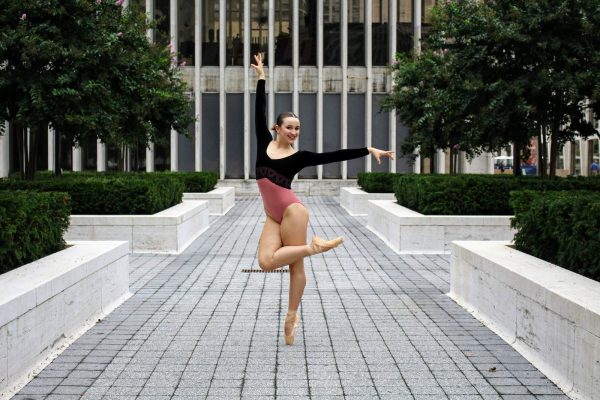An Evening of Dance, Fashion and Progress
October 10, 2018
On Thursday, Sept. 27, 2018, the annual Fall Gala at the New York City Ballet (NYCB) unofficially kicked off the start of the fall season with an unprecedented concentration on politics, fashion and rap music. While it may have only been one night of the 2018-19 season, this year’s gala revealed a NYCB season that is taking steps to change the discussion and relevancy of ballet.
At the start of the evening, before the dancing and couture took the stage, the curtain rose on the company’s 90 dancers. Principal dancers Adrian Danching-Waring and Teresa Reichlen read from a prepared statement acknowledging the impact of the recent sexual harassment allegations made against the company and three former dancers, stating that “with the world changing — and our beloved institution in the spotlight — we continue to hold ourselves to the high moral standards that were instilled in us when we decided to become professional dancers.” Perhaps seen as necessary to the company and patrons to reestablish a clean image, the statement instead read as an attempt to promote various policies that might provide absolution this season.
After a brief video about the costume designers and their work this evening, choreographer Matthew Neenan’s piece, “The Exchange,” commenced. While the music was purley classical, the sharp, dark red and black costumes, designed by Gareth Pugh, created problematic contrasts. Neenan seemed confused about the opening mood of his piece; he was torn between adhering to the music and following Pugh’s intent to bring ugliness to the ballet. With an overused motif of flexed hands and feet, Neenan tried to represent that ugliness but instead created awkwardness. Initial formations were not formations at all. The stage was littered with dancers in disconnected groups each doing different steps or just standing in an awkward pose in the background. Without a central focus, the piece came off as chaotic and in sore need of another rehearsal. Despite its initial bumps, towards the halfway point the choreography started to match the crescendo of the music, and the entire cast ran out to fill the stage with appealing formations. By the end of the piece Neenan had overcome an uncomfortable start.
Next up was Gianna Reisen’s “Judah,” her second choreographic commission for NYCB. Reisen, a 19-year-old dancer with the L.A. Dance Project, created a visual feast with her geometric formations that were accentuated by Alberta Ferretti’s colorful, flowing wave-like costumes that twirled with the dancers as they glided across the stage. Reisen played with the intricacies of John Adams’ music, allowing the dancers to bring to life the music with their movements. With her choreography, Reisen made basic steps, a tendu, port de bras and even a straight line something artistic and beautiful. The balanced formations and choreography of the corps dancers rendered an organic, aesthetically pleasing composition of pyramids that framed the soloists on center stage. She also experimented a bit in the partnering work between Lauren Lovett and Preston Chamblee with her diving into his circular arms and Lovette sliding into an assisted arabesque promenade. The choreography was intricate and quick, and, while not every moment worked well, specifically in Megan LeCrone’s solo where she shuffled backwards in a squat, overall Reisen created a ballet that NYCB founder Balanchine himself would have enjoyed seeing on his stage.
The highlight of the evening, however, was Kyle Abraham’s piece, “The Runaway,” a true 21st century ballet. With choreography that combined elements of ballet, modern and street dance to a medley of piano, violin, Kanye West and Jay-Z, Abraham challenged NYCB to go beyond the limits of what a ballet is “supposed to be.” Abraham’s choreography was innovative, primarily because the male dancers — Taylor Stanley, a standout among them — adapted and molded themselves to this new musical language. Stanley showcased such fluidity that a ripple through his shoulders appeared as a wave crashing through his body. Then in an instant he displayed extreme strength and control in his developes. In certain moments, such as when Kanye West and Jay-Z’s “Gotta Have It” started, the choreography did not match the music’s energy and the women’s execution did appear somewhat awkward. Yet the atmosphere in the theater and the creativity that Abraham brought to that stage is what shone brightly that night.
Overall, Abraham’s piece was a triumph, not just for the evening but for what it signals for NYCB’s future. By combining various forms of music, dance and lighting, “The Runaway” stripped the ethereal, elitist aspect from ballet; it made it more than just something pretty to watch. This piece gave ballet depth, challenging each traditional audiences on what they thought they knew about NYCB and ballet. And by bringing in both a young female choreographer and an African-American choreographer, NYCB, one of the premiere ballet companies in the U.S., is starting to realize that dance, especially ballet, is diverse.
While the Fall Gala is only one evening, its performances embodied the theme of the 2018-19 season, one defined by combining old and new works that showcase all forms of dance. In October the “La Sylphide” program, highlights Balanchine pieces alongside those influenced by Bernstein. Throughout the season repertoire that is not frequently performed, such as “Scotch Symphony” and “Valse Fantaisie,” will be brought back to the stage. And a highlight in the spring will be the “Balanchine Meets Peck” program highlighting Justin Peck’s “The Times Are Racing,” alongside Balanchine’s “Symphony in Three Movements.” This season NYCB seeks to make ballet meaningful for new and familiar audiences. Whether they succeed or not, we’ll have to see. But they are taking the first steps.










